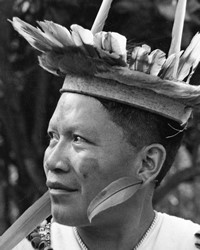Secoya, Angotero in Peru

Photo Source:
Anonymous
|
Send Joshua Project a map of this people group.
|
| People Name: | Secoya, Angotero |
| Country: | Peru |
| 10/40 Window: | No |
| Population: | 1,000 |
| World Population: | 2,000 |
| Primary Language: | Paicoca |
| Primary Religion: | Ethnic Religions |
| Christian Adherents: | 10.00 % |
| Evangelicals: | 0.00 % |
| Scripture: | New Testament |
| Ministry Resources: | Yes |
| Jesus Film: | No |
| Audio Recordings: | Yes |
| People Cluster: | South American Indigenous |
| Affinity Bloc: | Latin-Caribbean Americans |
| Progress Level: |
|
Introduction / History
Ever since first Western contact in 1599, the Secoya people have suffered greatly from epidemics and oppression. At the turn of the 20th century, rubber barons subjected the Secoya to a system of peonage and debt until war broke out between Peru and Ecuador in 1941. Caught between two armies, the Secoya were uprooted, and many communities lost contact with one another. After the war, they worked for oil companies for a few decades until the Colombian leftist group FARC forced them to flee violence once again, ending up near the headwaters of the Napo River.
The Summer Institute of Linguistics (SIL) began working with the Secoya in 1950, and they have since completed the New Testament. In 1969, SIL opened a Secoya school. However, SIL was forced to leave in 1981, and since then no missions organizations have worked with the Secoya in any manner.
Colombian members of the "Solo Jesús" (Only Jesus) church discipled a young Secoya man in their teachings and sent him to open a Solo Jesús church among the Secoya in 2006. However, many reputable evangelical organizations consider the Solo Jesús movement to be a sect, as its teachings severely depart from orthodoxy in doctrines related to the Trinity, salvation, baptism, the ministry of the Holy Spirit, etc. While believers have succeeded in turning away from sins like alcoholism and violence, they struggle to grow in their faith as a result of doctrinal errors.
Where Are they Located?
The Secoya live in the northern jungle region of Peru along the Yubineto, Yaricaya, Angusilla, and Santa Maria Rivers, which are tributaries of the Napo and Putumayo Rivers.
What Are Their Lives Like?
The Secoya live a daily subsistence lifestyle based on farming, fishing, and hunting. Principal crops include maize, manioc, plantains, sugarcane, sweet potatoes, and various fruits. Environmental changes have made it much more difficult to acquire fish and meat, so the Secoya have begun exploring alternative sources of food, like fish farming. Some Secoya have also begun raising livestock and commercial crops of coffee and maize.
Traditionally, the Secoya lived as large extended families in one long oval house with an open center, but today they live in smaller houses built on stilts. Men typically hunt, build houses and canoes, and clear farmland. Women prepare food, raise children, and make clothing. Both men and women work together in farming and fishing.
Artisan products include wood carvings, featherwork, clay pottery, ceramics, baskets, and woven hammocks and bags. The Secoya also produce one-stringed bows, bamboo flutes, and small drums, and ceramic trumpets. Face painting was formerly common, especially for participation in ayahuasca rituals. The Secoya have names for thousands of different plants and may be the ethnic group that uses the highest number of plants in the world.
What Are Their Beliefs?
The Secoya hold to animistic views that seek to discover spiritual causes for life problems and resolve them through shamanistic rituals. They believe that the cosmos is made of many overlapping worlds that can be perceived and navigated by the shaman, who functions as a helpful bridge between the material and the spiritual worlds. Because mysterious evil spirits abound, often hidden behind ordinary plants and animals, the shaman must take the hallucinogenic ayahuasca drug to enter into contact with the spirit world and discover both causes and solutions to problems like death, illness, and hunger. The Secoya believe that ayahuasca, which the creator first taught them to use, is the source of all knowledge and of discerning the difference between good and evil.
What Are Their Needs?
The Secoya need additional evangelization, discipling, and doctrinally sound Bible teaching that will help them understand the truth about God and grow in their faith.
The Secoya need to turn away from both religious legalism and the syncretism that tempts them to blend Christianity with traditional shamanistic practices.
Prayer Points
Please pray for Secoya believers to discern truth from error, read and understand Scripture for themselves, and apply the gospel to their daily lives.
Pray for more discipled Christians to go live among and minister to the Secoya people.
Pray that an increasing number of the Secoya would accept Jesus' free gift of salvation.
Pray against legalism and confusion in the Secoya church.